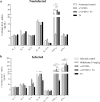Oral treatment with T6-loaded yeast cell wall particles reduces the parasitemia in murine visceral leishmaniasis model
- PMID: 31882925
- PMCID: PMC6934808
- DOI: 10.1038/s41598-019-56647-w
Oral treatment with T6-loaded yeast cell wall particles reduces the parasitemia in murine visceral leishmaniasis model
Abstract
Yeast cell wall particles isolated from Saccharomyces cerevisiae (scYCWPs) have a rich constitution of β-glucan derived from the cell wall. After removing intracellular contents, β-glucan molecules are readily recognized by dectin-1 receptors, present on the cytoplasmic membrane surface of the mononuclear phagocytic cells and internalized. Leishmania spp. are obligate intracellular parasites; macrophages are its primary host cells. An experimental murine model of visceral leishmaniasis caused by L. infantum was used to evaluate the antileishmanial activity of oral administration of these particles. A low-water soluble thiophene previously studied in vitro against L. infantum was entrapped into scYCWPs to direct it into the host cell, in order to circumvent the typical pharmacokinetic problems of water-insoluble compounds. We found that scYCWPs + T6 reduced the parasitic burden in the liver and spleen. There was an increase in IFN-γ levels related to nitric oxide production, explaining the reduction of the L. infantum burden in the tissue. Histological analysis did not show signals of tissue inflammation and biochemical analysis from plasma did not indicate signals of cytotoxicity after scYCWPs + T6 treatment. These findings suggested that scYCWPs + T6 administered through oral route reduced the parasitic burden without causing toxic effects, satisfying requirements for development of new strategies to treat leishmaniasis.
Conflict of interest statement
The authors declare no competing interests.
Figures




References
Publication types
MeSH terms
Substances
LinkOut - more resources
Full Text Sources
Molecular Biology Databases
Miscellaneous

